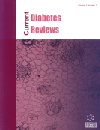-
s Association of High Levels of Spot Urine Protein with High Blood Pressure, Mean Arterial Pressure and Pulse Pressure with the Development of Diabetic Chronic Kidney Dysfunction or Failure among Diabetic Patients. Statistical Regression Modeling to Predict Diabetic Proteinuria
- Source: Current Diabetes Reviews, Volume 15, Issue 6, Dec 2019, p. 486 - 496
-
- 01 Dec 2019
Abstract
Introduction: In research elevated Blood Pressure (BP) has been demonstrated to be a risk for the development of nephropathy and chronic renal disease (CKD) Or Diabetic Kidney Disease (DKD) among diabetics. However, no study has find correlation for the spot urine protein (UPr) excretion with elevated BP, Pulse Pressure (PP) and mean arterial pressure MAP). This technique was invented in the current study. Methods: 10,270 were recruited for more than 12 years. Demographically, 43%, 38%, and 16% showed hypertension, nephropathy and chronic renal disease, respectively. UPr demonstrated significant correlations with systolic BP (SBP) and diastolic BP (DPB), MAP and PP (p < 0.0001 for all). SBP, DBP, PP and MAP, UPr were observed to be higher among the groups with nephroaphty and CKD/DKD with highly significant p-values (all p < 0.05). With logistic regression, odds ratio of hypertension (HTN) with nephropathy was observed to be 2.99 (95% CI 2.44 to 3.7; p < 0.0001); and odds ratio of HTN with CKD/DK was 7.1 (95% CI 4.3 to 11.84; p<0.0001), indicating that HTN significantly contributes to the development of nephropathy and CKD/DKD in diabetics. Results: Invented regression models for the excretion of UPr from the kidney with elevated SBP, DBP, MAP and PP were highly significant (p < 0.0001 for all); UPr = -138.6 + [1.347 SBP] ; UPr = -93.4 + [1.62 DBP] ; UPr = -149.5 + [1.922 × MAP] ; UPr = -41.23 +[1.541 PP]. Conclusion: Current study is the first one to introduce this technique. These invented new equations can be used by physicians to estimate protein excretion in urine at bedside and outpatients departments for monitoring proteinuria and CKD/DKD.


